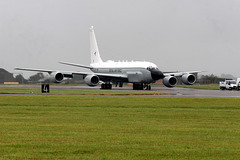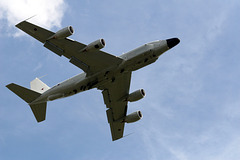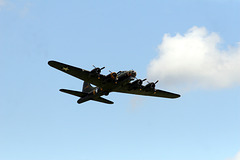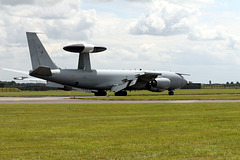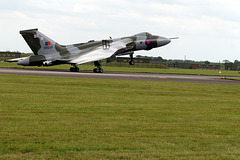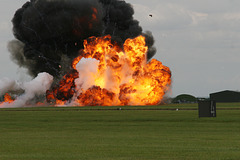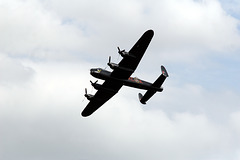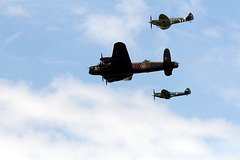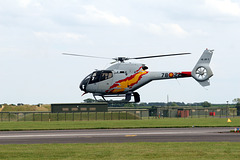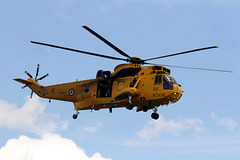
Aircraft
Boeing RC 135 Rivet Joint on Taxi run RAF Waddingt…
| |
|
|
|
The Boeing RC-135 is a family of large reconnaissance aircraft built by Boeing and modified by a number of companies, including General Dynamics, Lockheed, LTV, E-Systems, and L-3 Communications, and used by the United States Air Force and Royal Air Force to support theater and national level intelligence consumers with near real-time on-scene collection, analysis and dissemination capabilities. Based on the C-135 Stratolifter airframe, various types of RC-135s have been in service since 1961. Unlike the C-135 and KC-135 which are recognized by Boeing as the Model 717,] the RC-135 is internally designated as the Model 739 by the company. Many variants have been modified numerous times, resulting in a large variety of designations, configurations, and program names.
Boeing RC 135 Rivet Joint flypast at RAF Waddingto…
| |
|
|
|
Boeing B.17G Sally B display at RAF WADDINGTON 5th…
| |
|
|
Sally B is the name of an airworthy 1945-built Boeing B-17G Flying Fortress, it is the only airworthy B-17 left in Europe. The aircraft is based at the Imperial War Museum Duxford, England, Sally B flies at airshows in the UK and across Europe as well as serving as an airborne memorial to the United States Army Air Forces airmen who lost their lives in the European theatre during World War II.
The aircraft was delivered to the United States Army Air Forces (USAAF) on 19 June 1945 as 44-85784, too late to see active service in the war. After being converted to both a TB-17G training variant and then an EB-17G it was struck off charge in 1954. In 1954 the Institut Géographique National in France bought the plane for use as a survey aircraft. In 1975 it moved to England and was registered with the CAA as G-BEDF to be restored to wartime condition.
The Sally B was first fitted with accurate gun turrets and other much needed additions for her role as Ginger Rogers, a B-17 bomber of the fictitious bomber unit featured in the 1981 LWT series We'll Meet Again.
During the winter of 1983–84, Sally B was painted in an olive drab and neutral grey colour scheme, in place of the bare metal scheme she had worn since construction, in order to protect the airframe from the damp UK weather. At the same time, she received the markings of the 447th Bomb Group.
The Sally B was used in the 1990 film Memphis Belle as one of 5 flying B-17s needed for various film scenes, and it was used to replicate the real Memphis Belle in one scene. Half of the aircraft is still in the Memphis Belle livery,following restoration of the Sally B nose art and the black and yellow checkerboard pattern on the cowling of the starboard inner (no 3) engine, carried as a tribute to Elly Sallingboe's companion Ted White, whose Harvard aircraft had the same pattern on its cowling. Sally B was reworked to B-17F configuration for filming.
Since 1985, Sally B has been operated by Elly Sallingboe's 'B-17 Preservation Ltd and maintained by Chief Engineer Peter Brown and a team of volunteers. The aircraft is flown by volunteer experienced professional pilots. The B17 Charitable Trust exists to raise funds to keep the plane flying. In 2008, Elly Sallingboe was awarded the Transport Trust 'Lifetime Achievement Award' in recognition of over thirty years of dedication to the preservation and operation of Britain's only airworthy Boeing B-17 Flying Fortress as a flying memorial to the tens of thousands of American aircrew who lost their lives in her sister aircraft during the Second World War.
One of the key events in the flying calendar for Sally B is an annual tribute flypast following the Memorial Day service at the American Military Cemetery at Madingley, Cambridge. This takes place over the May Bank Holiday weekend. Flypasts over former Eighth Air Force bases are also carried out whenever possible during the summer months.
Boeing B.17G Sally B landing RAF Waddington,Lincol…
| |
|
|
Boeing E-3D Sentry AEW1 landing
| |
|
The Boeing E-3 Sentry, commonly known as AWACS, is an airborne early warning and control (AEW&C) aircraft developed by Boeing as the prime contractor. Derived from the Boeing 707, it provides all-weather surveillance, command, control, and communications, and is used by the United States Air Force, NATO, Royal Air Force, French Air Force, and Royal Saudi Air Force. The E-3 is distinguished by the distinctive rotating radar dome above the fuselage. Production ended in 1992 after 68 aircraft had been built.
Avro Vulcan B2 landing at RAF Waddington,Lincolns…
| |
|
|
|
The Avro Vulcan (later Hawker Siddeley Vulcan[ from July 1963)[3] is a jet-powered tailless delta wing high-altitude strategic bomber, which was operated by the Royal Air Force (RAF) from 1956 until 1984. Aircraft manufacturer A.V. Roe and Company (Avro) designed the Vulcan in response to Specification B.35/46. Of the three V bombers produced, the Vulcan was considered the most technically advanced and hence the riskiest option. Several scale aircraft, designated Avro 707, were produced to test and refine the delta wing design principles. Since retirement by the RAF one example, B.2 XH558, named "The Spirit of Great Britain" was restored for use in display flights and air shows, whilst two other B.2s, XL426 and XM655, are kept in taxiable condition for ground runs and demonstrations at London Southend Airport and Wellesbourne Mountford Airfield respectively. B.2 XH558 flew for the last time in October 2015, before also being kept in taxiable condition at Robin Hood Airport, Doncaster.
Aftermath of airfield Attack by Augusta Westland…
| |
|
|
SAAB AJS37 Viggen landing at RAF Waddington 5th Ju…
| |
|
The Saab 37 Viggen ("Thunderbolt", also "Tufted duck") is a Swedish single-seat, single-engine, short-medium range combat aircraft. Development work on the type was initiated at Saab in 1952 and, following the selection of a radical delta wing configuration, the resulting aircraft performed its first flight on 8 February 1967 and entered service in 21 June 1971. The Viggen holds the distinction of being the first canard design to be produced in quantity.
Several distinctive variants of the Viggen were produced to perform the roles of strike fighter (AJ 37), aerial reconnaissance (SF 37), maritime patrol aircraft (SH 37) and a two-seat trainer (SK 37). In the late 1970s, the all-weather fighter-interceptor aircraft JA 37 variant was introduced. In November 2005, the Viggen was retired from service by the Swedish Air Force, the sole operator of the type, having been replaced by the newer Saab JAS 39 Gripen.
Red Arrows BAe Hawk T.1 XX325 at RAF Waddington 5t…
| |
|
The Red Arrows, officially known as the Royal Air Force Aerobatic Team, is the aerobatics display team of the Royal Air Force based at RAF Scampton. The team was formed in late 1964 as an all-RAF team, replacing a number of unofficial teams that had been sponsored by RAF commands.
The Red Arrows badge shows the aircraft in their trademark diamond nine formation, with the motto Éclat, a French word meaning "brilliance" or "excellence".
Initially, they were equipped with seven Folland Gnat trainers inherited from the RAF Yellowjacks display team. This aircraft was chosen because it was less expensive to operate than front-line fighters. In their first season, they flew at 65 shows across Europe. In 1966, the team was increased to nine members, enabling them to develop their Diamond Nine formation. In late 1979, they switched to the BAE Hawk trainer. The Red Arrows have performed over 4,700 displays in 56 countries worldwide.
SAAB Sk35C Draken landing at RAF Waddington 5th Ju…
| |
|
The Saab 35 Draken ("the kite" or "the dragon") was a Swedish fighter aircraft manufactured by Saab between 1955 and 1974. The Draken was built to replace the Saab J 29 Tunnan and, later, the fighter variant (J 32B) of the Saab 32 Lansen. The indigenous J 35 was an effective supersonic Cold War fighter that was also successfully exported to Austria, Denmark, Finland, and to the United States as a test pilot training aircraft.
The Draken was the first fully supersonic aircraft to be deployed in Western Europe.
BBMF Avro Lancaster B1 display at RAF Waddington…
| |
|
|
|
PA474 is one of only two Lancaster aircraft remaining in airworthy condition out of the 7,377 that were built (the other is in Canada with the Canadian Warplane Heritage Museum at Hamilton, Ontario). PA474 rolled off the production line at the Vickers Armstrong Broughton factory at Hawarden Airfield, Chester on 31 May 1945, just after the war in Europe came to an end, so she was prepared for use against the Japanese as part of the ‘Tiger Force’. However, the war in the Far East also ended before she was deployed and she did not take part in any hostilities. After a period in storage, PA474 was converted for photo reconnaissance work; modifications for these duties included being stripped back to a bare metal (silver) finish and the removal of all her gun turrets. She was then assigned to aerial survey duties with No 82 Squadron in East and South Africa from September 1948 until February 1952.
On return to the United Kingdom, PA474 was loaned to Flight Refuelling Ltd at Tarrant Rushton to be used as a pilotless drone, an uncertain future, which would likely have led to her loss. Fortunately, however, before the conversion started, the Air Ministry decided to use a different type of aircraft for the drone programme (a Lincoln) and PA474 was reprieved. She was then transferred to the Royal College of Aeronautics at Cranfield where she was used as a trial platform for the testing of various experimental aerofoil sections between 1954 and 1964; the trial wings being mounted vertically on the upper rear fuselage.
In 1964 PA474 was adopted by the Air Historical Branch with a view to putting the aircraft on display as a static exhibit in the proposed RAF Museum at Hendon. She was flown to Wroughton where she was painted in a camouflage paint scheme, though without squadron markings, and it was during this period that the aircraft took part in two films, ‘Operation Crossbow’ and ‘The Guns of Navarone’. Later in 1964, she was moved to RAF Henlow and grounded in preparation for display at the RAF Museum.
In 1965, Wing Commader D’Arcy, the Commanding Officer of 44 Squadron (then flying Vulcans at RAF Waddington) asked permission for PA474 to be transferred into the care of the Squadron. An inspection found that the aircraft was structurally sound so permission was granted for PA474 to make a single flight from Henlow to Waddington, which it completed in August 1965. At Waddington a restoration programme began on the Lancaster and by 1966 work was progressing well with both the front and rear turrets in place. Permission to fly PA474 regularly was granted in 1967, whilst restoration continued. The Lancaster joined the Battle of Britain Memorial Flight in November 1973 and restoration work on various parts of the aircraft has continued ever since. A mid-upper turret was discovered in Argentina and was brought to Britain aboard HMS HAMPSHIRE; it was fitted to PA474 in 1975. In the same year, the aircraft was adopted by the City of Lincoln, permission being granted for her to display the City’s coat of arms, which will always be displayed on PA474 regardless of what colour scheme she wears.
PA474 is currently painted to represent Lancaster DV385, “Thumper Mk III” of 617 (‘Dambuster’) Squadron, with the code letters ‘KC-A’. This aircraft was one of the brand-new standard Lancasters issued to 617 Squadron as replacements after the ‘Dams Raid’ in 1943. It was delivered to the Squadron in November 1943, whilst the unit was based at Coningsby, and it flew 4 ‘ops’ from Coningsby before 617 Squadron moved to Woodhall Spa in January 1944. The “Thumper” nose art features the cartoon rabbit – from the 1942 Walt Disney cartoon ‘Bambi’ – holding a foaming pint of beer.
Although the real “Thumper Mk III” flew a total of 50 ‘ops’, the ‘bomb log’ under the cockpit on PA474 displays 35 ‘ops’ as shown in a wartime photograph. The bomb symbols include one with a ‘D’ for Operation ‘Taxable’ (the ‘spoof’ D-Day chaff mission on 5/6th June 1944) and one with a swastika denoting a kill against a German fighter. “Thumper Mk III” dropped a total of 15 of the huge ‘Tallboy’ ‘earthquake’ bombs; it was involved in many important missions, including the first ‘Tallboy’ raid against the Saumur railway tunnel on 8th June 1944 and many raids against ‘V’ weapon sites. Between February and August 1944, the aircraft was mostly flown by Flying Officer (later Flight Lieutenant) Bob Knights DSO DFC and his crew.
BBMF display at RAF Waddington 5th July 2014
| |
|
|
|
The Battle of Britain Memorial Flight (BBMF) is a Royal Air Force flight which provides an aerial display group comprising an Avro Lancaster, a Supermarine Spitfire and a Hawker Hurricane. The aircraft are regularly seen at events commemorating the Second World War and upon British State occasions, notably Trooping the Colour, celebrating Queen Elizabeth II's 80th birthday in 2006, as well as the wedding of Prince William, Duke of Cambridge and Catherine Middleton in 2011 and at air displays throughout the United Kingdom and Europe.
The flight is administratively part of No. 1 Group RAF, flying out of RAF Coningsby in Lincolnshire.
Red Arrows,Hawker Hunter & 2 Knats at RAF Waddingt…
| |
|
|
The Reds at RAF Waddington 5th July 2014
| |
|
Spanish Air Force Patrulla ASPA- Eurocopter EC 120…
| |
|
"Patrulla ASPA" are the current Spanish Air Force helicopter aerobatic display team, flying with five Eurocopter EC-120 Colibri helicopters.
The Patrulla ASPA aerobatic team was formed on Sept 23, 2003 at the Armilla Air Base.
The first demonstration of the new team was on May 16, 2004 in Sevilla and their foreign debut was at the Portugal Air Show in 2005.
Westland Sea King HAR3A 202 flight at RAF Waddingt…
| |
|
|
|
The Westland Sea King HAR3 entered RAF service in 1978 and the 3A in 1996; both marks of aircraft are used in the Search and Rescue (SAR) role. The aircraft are operated from six locations around the UK, with each location supporting two aircraft. There is also a detachment of two HAR3s providing SAR cover in the Falkland Islands. The SAR squadrons provide 24-hour cover around the UK and the Falkland Islands throughout each year. Each squadron maintains a 15-minutes readiness state during daylight hours and a 45-minutes readiness state during the hours of darkness.
For the search aspect of its role, the Sea King is able to operate to precise navigational standards and is fitted with a multi-band homing system, satellite navigation systems, a search radar, a comprehensive avionics suite and a large selection of radios. For its rescue role, the aircraft is equipped with a hydraulically-operated main rescue hoist, an electrically-operated emergency rescue hoist and electrical connections suitable for powering medical equipment such as incubators. The SAR fleet of Sea Kings are fitted with a video/infrared detection pod, which is similar to the equipment used by police helicopters, to help search for casualties. All SAR crews are trained to operate using night-vision goggles over unfamiliar terrain. The standard SAR crew is made up of four members: two pilots, one of whom is the aircraft captain, a radar operator who acts as the winch operator at the rescue scene and a winchman, normally trained to paramedic standard, who will supply immediate first-aid and recovery services at the rescue site.
Canadian Lancaster landing at RAF Waddington 21st…
| |
|
|
|
FM213 - airworthy with the Canadian Warplane Heritage Museum out of Hamilton, Ontario as C-GVRA. Built at Victory Aircraft in Malton, Ontario, in 1945, this aircraft didn't see combat in Europe before the end of the war. It was later used for Search and Rescue operations under Maritime Air Command) before being retired from service on 6 November 1963. It was displayed in Goderich, Ontario from 1964 to 1977 then stored at Dunnville, Ontario. FM213 had 4,392.3 hours on the airframe when it was handed over. It would probably have been sold for scrap metal except for the intervention of The Royal Canadian Legion branch in Goderich, ON. The aircraft was acquired by Canadian Warplane Heritage Museum in 1978, underwent a 10-year restoration, and has remained airworthy since 1988. The aircraft is flown in the paint scheme of KB726 coded VR-A, depicting the aircraft of No. 419 Squadron RCAF in which Canadian Andrew Mynarski won the Victoria Cross. It has thus been named the "Mynarski Memorial Lancaster", but is known colloquially as "Vera". C-GVRA departed Hamilton, Ontario on 4 August 2014, to take part in a series of events in the UK in formation with the world's only other airworthy Lancaster, PA474, during August and September. The North Atlantic crossing included en-route stops at Goose Bay Canada, Narsarsuaq Greenland, and Keflavik Iceland before arriving at RAF Coningsby, home of the Battle of Britain Memorial Flight. This was purported to be the first Atlantic crossing by a Lancaster since 1975.
The BBMF Lancaster and the Canadian Lancaster tax…
| |
|
|
Jump to top
RSS feed- Latest items - Subscribe to the latest items added to this album
- ipernity © 2007-2024
- Help & Contact
|
Club news
|
About ipernity
|
History |
ipernity Club & Prices |
Guide of good conduct
Donate | Group guidelines | Privacy policy | Terms of use | Statutes | In memoria -
Facebook
Twitter

